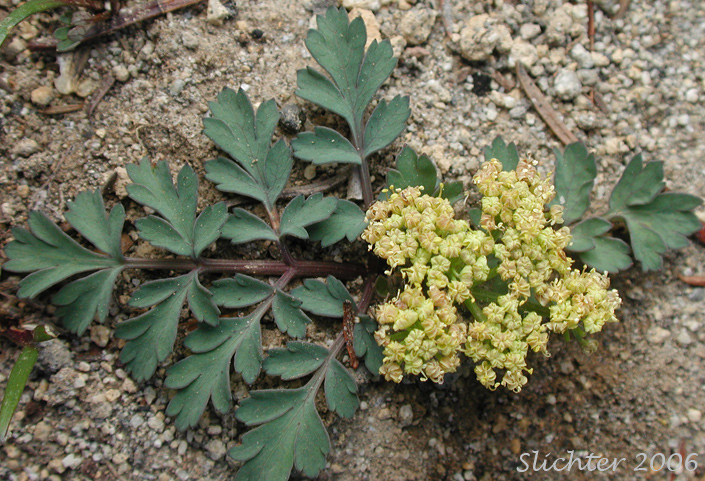
 The
photo at right shows a close-up of the fruits of martindale's desert parsley
as seen atop Potato Hill which is several miles north of Mt. Adams.......July
11, 2005.
The
photo at right shows a close-up of the fruits of martindale's desert parsley
as seen atop Potato Hill which is several miles north of Mt. Adams.......July
11, 2005.
Cascade desert parsley is an attractive (especially with its glaucous-gren, fern-like foliage) perennial wildflower with one to several flower scapes rising frooom 15-40 cm high from a cluster of basal leaves. The herbage of the stems and leaves is largely glabrous, although it may occasionally be minutely rough. The leaves are pinnately or ternate-pinnately once to twice compound with less than 60 toothed to cleft leaflets (See photo below.). The blades measure from 3-15 cm long with the leaflets ovate to oblong in shape, each measuring 8-15 mm long with obtuse to acute teeth on the margins. The petioles measure 2-5 cm long with the base widening to a broad membranous sheath.
The inflorescence is a 4-16 rayed umbel with the rays 1.5-7 cm long in fruit. Individual umbellets consist of 2-6 flowers, each with pedicels 2-8 mm long. Frequently, only 1-3 fertile flowers are found per umbellet. Involucres and involucels at the base of the rays are generally lacking. The flowers range from yellow to yellow-white or creamy in color. The fruits are dark purplish in color, narrowly oblong in shape, with prominent dorsal and intermediate ribs, and measuring from 6-16 mm long.
Martindale's desert parsley may be found on rocky slopes and in dry meadows and dry, open coniferous forest from middle levations to subalpine habitats in the mountains. In the Columbia River Gorge, it may be found nearly to sea level, usually on cliffs and rocky slopes.
Martindale's desert parsley may be found trom southern British Columbia south through the Cascade Mts. of Washington to southern Oregon. It is also found in the Olympic Mts. of Northwestern Washington and the coast range of Oregon.